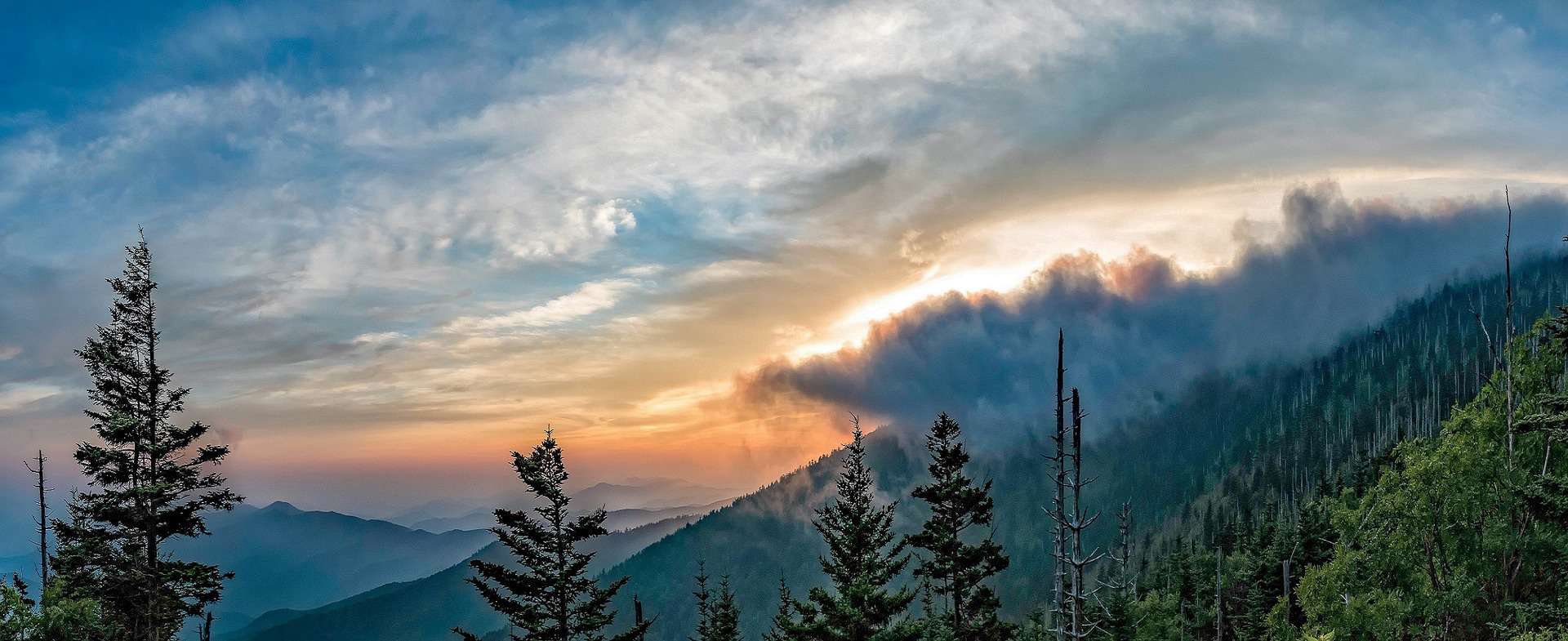
The Great Smoky Mountains National Park is the most visited National Park in the U.S. With halves in Tennessee and North Carolina, it features over 520,000 acres to wander. Changing with the seasons, wildflowers pop, painting the forest floor in the spring. During the summer, the synchronous fireflies dazzle with a light show. As the weather cools, fall foliage attracts leaf peepers from all corners. Finally, the winter offers a snow-draped landscape to explore. Like any national park visit, planning is important. Here are the top things to do in Great Smoky Mountains National Park.
Top Things to Do in Great Smoky Mountains National Park
- Stop at a Visitor Center.
- See some of the Top Sites
- Take a Scenic Drive.
- Hike in the Smokies.
- See a waterfall.
- Bike along a trail.
- Take a horseback ride.
- Earn a Junior Ranger Badge.
- See some wildlife.
- Camp in one of the campgrounds.
Great Smoky Mountains National Park at a Glance
| Year Established: 1934 |
| Located: Tennessee and North Carolina |
| Size: over 520,000 acres |
| Best Features: Waterfalls, Forests and views of the Great Smoky Mountains |
Why Visit the Great Smoky Mountains
This might be one of the top 10 most visited national parks; however, it doesn’t feel crowded. As a mountain park, I recommend taking a scenic drive through the Smokies. Another must-do is hiking to one of its waterfalls.
I recommend learning about the people of Appalachian and the Appalachian Mountains. If the weather is clear, then I recommend driving up to Clingman’s Dome to see for miles.
With its easy access to popular gateway areas of Pigeon Forge and Gatlinburg, it is easy to day trip into the park.
Visitor Centers in the Great Smoky Mountains
This is one of the top things to do in Great Smoky Mountains National Park.
Sugarlands Visitor Center
1420 Little River Road Gatlinburg, Tennessee
Open daily from 8 a.m. to 5 p.m. (6:30 p.m. during the summer). Interpretive film along with exhibits. Backcountry Permit Office. Trolley Service from Gatlinburg.
Oconaluftee Visitor Center
Located north of Cherokee, North Carolina, entrance.
Mountain Farm Museum is located nearby. Open daily from 8 a.m. to 5 p.m.
Cades Cove Visitor Center
Located near the Townsend, Tennessee, entrance.
Open daily from 9 a.m. to 5 p.m. (4:30 p.m. in winter).
Clingmans Dome Visitor Center
Located at the base of the Clingmans Dome Observation Tower. Open daily from 10 a.m. to 6 p.m. Closed from December 1 to March 31.
33 Musts for Pigeon Forge and Gatlinburg
Top Sites in the Great Smoky Mountains
Cades Cove
This popular area is south of Townsend, Tennessee, and features the Cades Loop Road. Along the highest concentration of historic buildings, you can find lots of wildlife viewing opportunities. Additionally, Cades Cove features a visitor center, campground, and horse camp.
Clingmans Dome
At 6,643 ft (2,024m), it’s the highest point in the park and in Tennessee. It’s also the third-highest peak on the East Coast. Find a paved path to the observation tower off Newfound Gap Road.
Roaring Fork
As a Motor Nature Trail close to Gatlinburg, it’s a popular destination. Find waterfalls along historic buildings.
Deep Creek
Located on the southern edge of the park, near Bryson City, North Carolina. This area is known for its creeks, waterfalls and fishing. Find seasonal camping and hiking as well.
Cataloochee
Located on the east side of the park on the North Carolina side, and the road into the area is narrow and winding. Find an elk herd in Cataloochee, along with historic buildings. Cataloochee Creek is noted for wild trout. Also find camping along with a horse camp.
Elkmont
A hub for activity from early logging to a private resort area to a Civilian Conservation Corps camp. Located southeast of Sugarlands Visitor Center, south of Gatlinburg, Tennessee. Find a large campground along with historic cabins, like the Appalachian Clubhouse.
Mountain Farm Museum
Located next to the Oconaluftee Visitor Center, north of Cherokee, North Carolina. Find a collection of log buildings reconstructed in this area. Walk through a farmhouse and outbuildings, like a springhouse, barn and blacksmith shop.
Newfound Gap
At 5,046 ft. (1,538m), it’s the lowest drivable mountain pass, so this area offers some of the best views without a hike. It’s located near Clingmans Dome.
Nashville Weekend Itinerary

Scenic Drives in the Great Smoky Mountains
As one of the easiest ways to explore the park, here are the scenic drives in the Smokies. This is one of the top things to do in Great Smoky Mountains National Park.
Cades Cove Loop
An 11-mile one-way road near the west side of the park
Newfound Gap Road
A 33-mile road that bisects the park from north to south
Roaring Fork Motor Nature Trail
A 5.5-mile one-way narrow road near Gatlinburg
Upper Tremont Road
A 2-mile road on the east side of the park, just south of Townsend.
Hiking in the Great Smoky Mountains
Find 70 miles of the Appalachian Trail (AT), the legendary trail that bisects its namesake mountain range from Georgia to Maine. This is one of the top things to do in Great Smoky Mountains National Park.
Clingmans Cove—.5-mile paved trail to lookout and highpoint in the Great Smoky Mountains National Park
Kephart Prong Trail—4-mile roundtrip trail between Newfound Gap and Smokemont
Porters Creek—2-mile roundtrip trail near Greenbrier Cove
Charlies Bunion—4-mile one-way trail to the scenic rock outcropping on the AT
Alum Cave Trail—2.5-mile one-way trail with 1,000-foot elevation change, south of Sugarlands VC
Forney Ridge Trail—1.8-mile one-way trail to Andrews Bald, near Clingmans Dome
Rainbow Falls—2.7-mile one-way to falls
Laurel Falls—2.6-mile paved round trip trail between Sugarlands and Cades Cove
Check out the Hike the Smokies for Families booklets ($1.00) available at any visitor center. You can hike miles and collect mileage stickers.
Top Things to Do in Branson Missouri
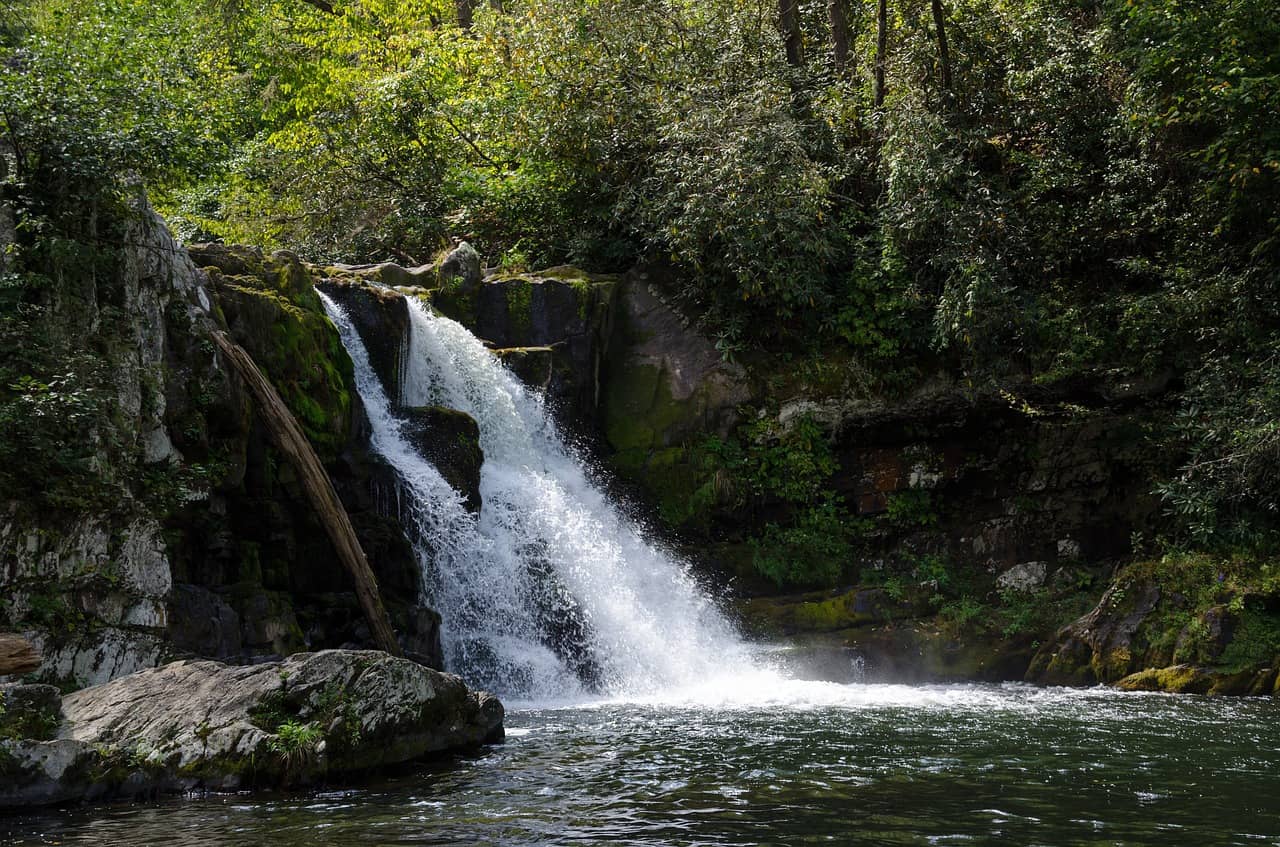
Waterfalls in the Great Smoky Mountains
Visiting a waterfall is one of the top things to do in Great Smoky Mountains National Park. Several waterfalls don’t require a hike.
Meigs Falls
Off Little River Road, 13 miles west of Sugarlands Visitor Center.
The Sinks
Off Little River Road, 12 miles west of Sugarlands Visitor Center.
Place of Thousand Drips
Off Roaring Fork Motor Nature Trail at Stop 15.
Waterfalls Hikes
Tom Branch Falls and Deep Creek Falls—A 1.6-mile round-trip hike on Deep Creek Trail
Laurel Falls—A 2.6-mile round-trip hike on Laurel Falls Trail
Lynn Camp Prong Cascades—A 1.3-mile walk on Middle Prong Trail on Tremont Rd.
Biking in the Great Smoky Mountains
Bicycling is allowed on most roads through not best suited for Newfound Gap Road.
Cades Cove Loop—11-mile one-way paved road. Rentals are available in the nearby campground.
Gatlinburg Trail—1.9-mile multi-use trail near Gatlinburg, TN.
Oconaluftee River Trail—1.5-mile multi-use trail near the Oconaluftee Visitor Center
Mountain biking isn’t permitted on other hiking trails in the park.
Guide to Kentucky’s Mammoth Cave National Park
Horseback Riding in the Great Smoky Mountains National Park
Find four authorized concessionaires in the park. Age and weight restrictions apply. Reservations are recommended. Rides are offered from mid-March to the end of November.
Cades Cove—Offering hayrides, carriage rides and guided one-hour. trail rides.
Smoke Mount—Offering wagon rides and guided trail rides from one hour to four hours.
Smoky Mountains—Offering 45-minute trail rides
Sugarlands—Offering one to four-hour guided trail rides.
Fishing in the Great Smoky Mountains National Park
With 2,900 miles of streams, the Great Smoky Mountains National Park protects the largest wild trout habitats in the eastern U.S. Fishing is permitted year-round with a valid Tennessee or North Carolina license, and both licenses are valid in the park and don’t require a special trout license.
The daily limit is five trout with size restrictions. Fishing licenses are available outside of the park’s boundaries.
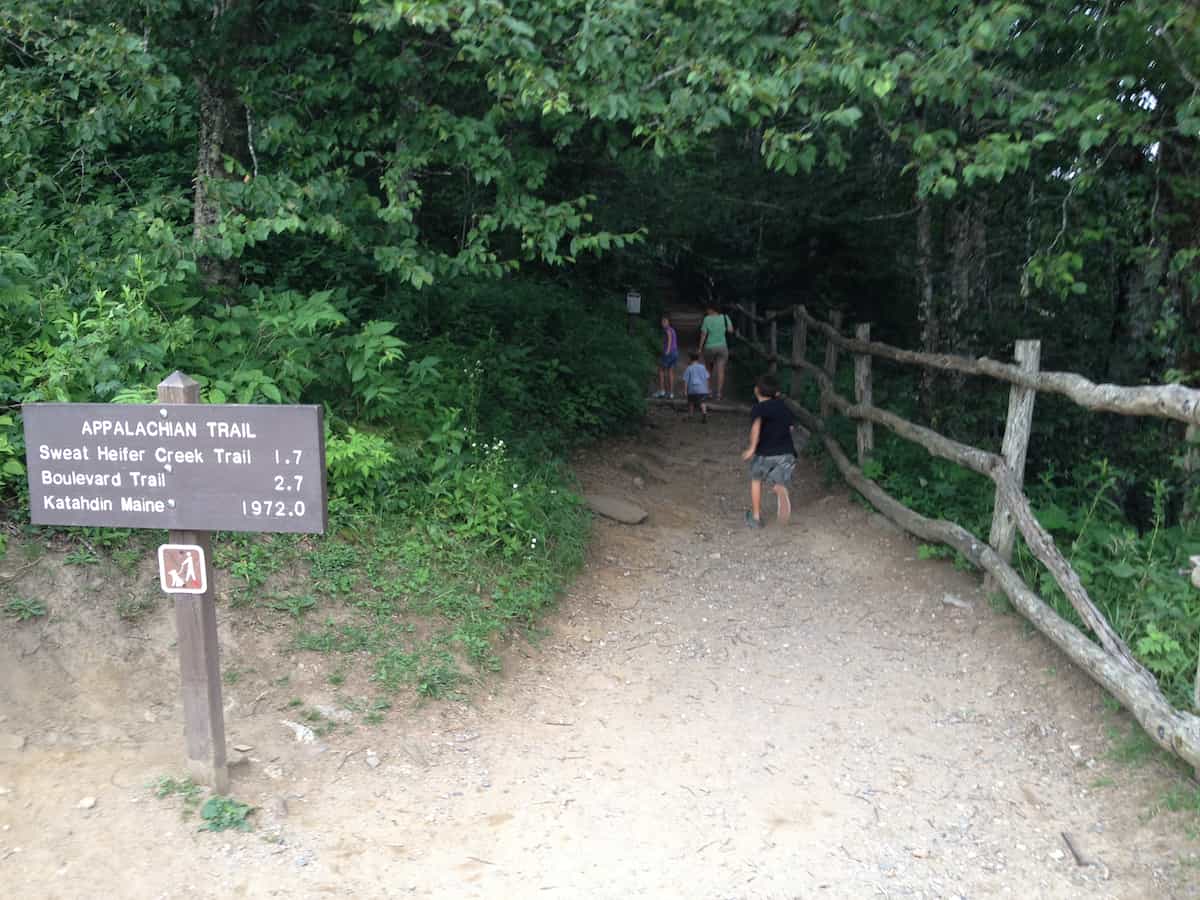
Kids in the Great Smoky Mountains
The Junior Ranger Program is the go-to program for families to learn more about the Great Smoky Mountains National Park. It’s free and takes about two hours to complete. My kids love the badges that the Rangers present them after completing their booklet.
You can pick up a booklet at any visitor center, complete the age-appropriate activities, and return for a souvenir badge and certificate.
In addition to the Great Smoky Mountains National Park Junior Ranger Badge, earn a World Heritage in the U.S. Junior Ranger badge.
BARK Program
The Great Smoky Mountains National Park welcomes pets as long as they practice the principles of the BARK program. For more information, visit the Great Smoky Mountains National Park page for visiting with pets.
B–Bag waste and dispose of it in the trash
A–Always leash your dog for their safety and others
R–Respect wildlife
K–Know where you can go
Due to the wilderness, dogs are not allowed on most trails in the Great Smoky Mountains National Park, except for the Gatlinburg Trail and the Oconaluftee Trail. Pets are allowed in campgrounds, picnic areas and along the roads inside the park.
Guide to Junior Ranger Badges
Wildlife Viewing in the Great Smoky Mountains National Park
Synchronous Fireflies
As the only species of fireflies, or lighting bugs, in North America to flash in unison, their mating season is a nighttime light show. Beginning in late May, the fireflies start their annual mating ritual that typically lasts for about two weeks of the insect’s 21-day adult life span.
Fireflies use bioluminescence to produce cool light, which means the energy used is 90% light and not heat, unlike traditional lightbulbs. The mating season is determined by the air and soil temperatures where the firefly larvae live.
To see this natural show, the National Park Service uses a lottery system, available on Recreation.gov. Each applicant can request two dated parking spots. For the 8-day window of reservations, a total of 1800 parking spots are granted for $25 each night. Each application is $1.
If the applicant wins the lottery for a parking spot, the fee is $24. Parking is at the Sugarlands Visitor Center and a $2 per person shuttle fee applies to get to the area.
Remember to use a red filter on your flashlight to prevent upsetting the fireflies’ nightly show.
Crater of Diamond State Park in Arkansas
Bears in the Great Smoky Mountains
Great Smoky Mountains is the home to the American black bear. As the largest protected area on the East Coast, there are about 1500 black bears in the park.
Though encounters are rare, Park Rangers offer some guidelines to reduce bear encounters:
- Remain observant.
- Hike in groups.
- Keep campsites clean.
- Make noise while hiking by wearing bear bells and talking.
- Don’t approach bears or let bears approach you.
- If a bear notices you, you are too close. Back away slowly and if attacked, fight back. Don’t play dead.
Other Animals in the Smokies
As a mountainous forest region, the Smokies are home to many animals. Animal viewing is one of the top things to do in the Great Smoky Mountains National Park.
- Elk
- White-tailed deer
- Coyote
- Gray and Red Fox
- Beaver
- Woodchuck
- 240 Species of Birds
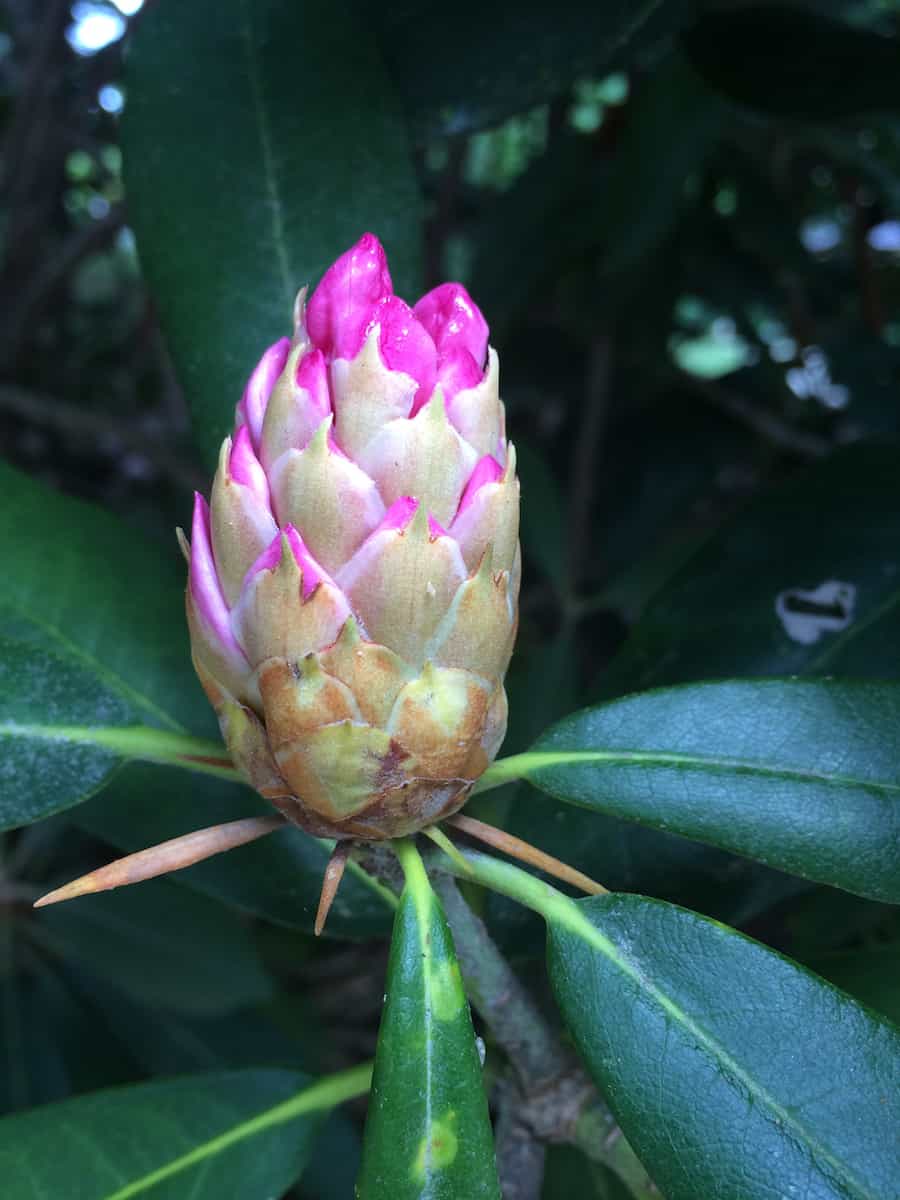
Wildflowers in the Great Smoky Mountains
Find over 1,500 different flowering plants in the Great Smoky Mountains National Park. It’s often called the Wildflower National Park and a top park for flowers.
Spring wildflowers, like the trillium, begin in early February. We continue to see wildflowers throughout the season, including the lady slipper orchids and the dwarf iris.
Flowering shrubs like mountain laurels, flame azelas and rhododendon offer a flowery show, too. The park also hosts the Spring Wildflower Pilgrimage in April, which has several days of programming.
Summer blooms include Turk’s cap, Butterfly weed and black-eyed Susan. Consider hiking the Oconaluftee River Trail, Deep Creek Trail or the Gregory Ridge Trail in Cades Cove for the best wildflower viewing.
Fall Color in the Great Smoky Mountains
Plan an autumn trip to the Smokies for one of the top places to see fall color. With about 100 native tree species, find several types of maples along with American beech, scarlet oak, sweet gum and hickories.
The fall color season runs from September to November, depending on elevation. Take a scenic drive for the easiest way to see fall color though expect traffic delays.
Roaring Fork Motor Nature Trail
Blue Ridge Parkway
Foothills Parkway
Clingmans Dome
Best Places for Music in Memphis
The History of the Great Smoky Mountains National Park
Chartered in 1934, the land was purchased from individuals and lumber operations. The Civilian Conservation Corps arrived as a Works Progress Administration program in 1933 and stayed until 1943.
President Franklin D. Roosevelt dedicated the national park in 1940. It became a UNESCO World Heritage Site in 1983.
The People of the Great Smoky Mountains
Cherokee People
Part of the Iroquois nation, the Cherokee people have lived in the Great Smoky Mountains for 1,000 years. Living in communities near fertile rivers, they constructed homes of saplings or logs.
The Cherokee society is maternal and lineage is traced through a mother’s side. The Cherokee language is a written language with 86 characters.
After the signing of the Treaty of New Echota, the Cherokee People were evicted and forced to move to Oklahoma. More than 4,000 people died in the Trail of Tears.
The Walker Sisters
After the Civil War, the Walker family had 13 children in Little Greenbrier Cove. Though some married and moved on, five unmarried daughters inherited the farm after their father died in 1921.
The sisters worked the farm together and stayed on with a lifetime lease after the park was created. They welcomed visitors to the area and sold crafts and traditional food for many years.
Their original farm became known as Five Sisters Cove and included the Little Greenbrier Schoolhouse, built by their father and brother. Both the log house and schoolhouse are still standing.
The CCC
During the Great Depression FDR created the Civilian Conservation Corps to put young men to work building many national and state parks. Using native construction materials located on-site, the CCC corps built roadways and trails and constructed buildings across the U.S.
Nearly 4,000 enrollees worked in the Great Smoky Mountains National Park. During their time there, they constructed many of the roads, fire watch towers and other structures throughout the park.
The CCC grew native trees and reforested areas of the park clearcut by lumber companies. They also built fish ponds to hatch trout for the park’s rivers.
CCC stone masons built the guard rails and the Elkmont Bridge during their tenure.
Chickasaw National Recreation Area in Oklahoma
Lodging in Great Smoky Mountains National Park
LeConte Lodge
Accessible by hiking a 5 to 8-mile trail, LeConte Lodge sits near the top of Mt. LeConte. Enjoy rustic accommodations with a hot breakfast and dinner. Light is by lantern, and sleep in bed with Hudson Bay wool blankets. Rates start at $176 per person per night.
Camping in the Great Smoky Mountains
Nightly camping fees start at $30 a night.
Abrams Campground
-
- Open April – October
- Reservations Required
- 16 sites with a 12-foot RV limit
- Potable water and flush toilets
Balsam Mountain Campground
-
- Open May – October
- Reservations Required
- 43 sites with a 30-foot RV limit
- Potable water and flush toilets
Big Creek Campground
-
- Open April – October
- Reservations Required
- 12 sites and No RVs
- Potable water and flush toilets
Cades Cove Campground
-
- Year-round
- Reservations required
- 161 sites with a Dump Station and 35-foot RV limit with a 40-foot motor home limit
- Potable water and flush toilets
Cataloochee Campground
-
- Open April – October
- Reservations Required
- 27 sites with a 31-foot RV limit
- Potable water and flush toilets
Cosby Campground
-
- Open April – October
- Reservations Required
- 157 sites with a 25-foot RV limit
- Potable water and flush toilets
Deep Creek Campground
-
- Open April – October
- Reservations Required
- 92 sites with a 25-foot RV limit
- Potable water and flush toilets
Elkmount Campground
-
- Open March – November
- Reservations Required
- 211 sites with a Dump Station, a 32-foot RV limit and a 35-foot Motorhome limit
- Potable water and flush toilets
Look Rock Campground
-
- Open March – November
- First Come, First Serve
- 68 Sites with no RV limit
Smokemont Campground
-
- Year-round
- Reservations Required
- 142 sites with a Dump Station, a 35-foot RV limit and a 40-foot Motorhome limit
- Potable water and flush toilets
Camping Packing List
Gateway Towns
Gatlinburg, Tennessee
Located to the north of the Great Smoky Mountains National Park. As a four-season destination, travelers will find dining, lodging and attractions in the Gatlinburg and Pigeon Forge area. There is a shuttle to the Sugarlands Visitor Center from Gatlinburg. The McGhee Tyson Regional Airport (TYS) is just south of Knoxville, about 40 west of Gatlinburg.
Cherokee, North Carolina
Located at the southern entrance of the park, visitors will find an assortment of lodging and dining along with the Museum of the Cherokee Indian. This is the closest town to the Oconaluftee Visitor Center. Air travelers can use the Asheville Regional Airport (AVL) for air transportation, about 60 miles east of Cherokee.
Townsend, Tennessee
Located 20 miles south of Knoxville, Tennessee, Townsend is closest to the Cades Cove area. Here, you can find traveler services and activities.
Weather in the Great Smoky Mountains National Park
Winter: Highs—low 40sF (4 to 7C) Lows—20sF (-3 to -5C)
Spring: Highs—60sF (15 to 19C) Lows— (16 to 19C)
Summer: Highs—70sF ( 22 to 25C) Lows—50sF (11 to 14C)
Fall: Highs—60sF (15 to 19C) S Lows—40sF (4 to 9C)
Rainfall is consistent year-round, with 5 to 7 inches ( 140 to 180mm) monthly.
Details on Visiting the Great Smoky Mountains National Park
The Great Smoky Mountains National Park is open 365 days a year, 24 hours a day. Unique to the Great Smoky Mountains National Park, a parking tag is required. This is a physical tag that can purchased in the area at visitor centers, kiosks or through Recreation.gov. It must be displayed on the vehicle’s dashboard.
Daily Parking Pass $5
Weekly Parking Pass $15
Annual Parking Pass $40
Note: It is still free to pass through the park.
There are EV recharging stations at the Sugarlands and Oconaluftee visitor centers. You can pick up a free visitor map at any visitor center. GPS directions are frequently incorrect inside the park. Check for seasonal road closures before departing. Cellular service is unreliable in the park.
U.S. Highway 441 (Newfound Gap Road) bisects the park.


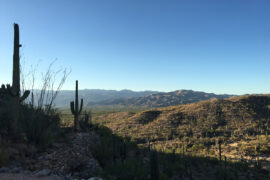

Comments are closed.